
|
 |
Mitsubishi G4M Betty by Larry Dwyer |
 |
 |
 |
 |
 |
|---|---|---|---|---|---|---|---|
 |
 |
 |
 |
 |
|||
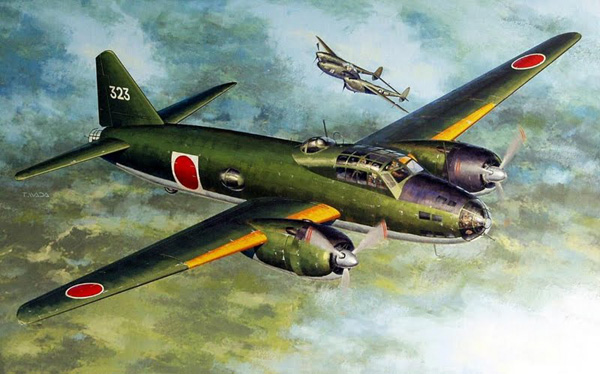 |
|||
|
The Mitsubishi G4M Betty was designed for maximum speed and range, but survivability was the tradeoff.
| |||
|
In 1937, the Imperial Japanese Navy was looking to replace the G3M twin-engine bomber/transport which had just been placed in service. Although the G3M was already considered the best land-based navy bomber in the world, new specifications (Shi-12 Attack Bomber) were issued demanding even greater speed, range and performance. This would require more powerful engines and a low-drag lightweight structure. The plane that was developed was the twin-engine Mitsubishi G4M Navy Type 1 Attack Bomber. It was codenamed Betty by the Allies. It was built in greater numbers than any other Japanese bomber and it became the most famous Japanese bomber of World War II. When it first appeared west of the Gilbert Islands, the Allies were surprised and thought that the bombers were carrier based. They were aware of the Mitsubishi Ki.21 and the Mitsubishi G3M, but it was never imagined that the Japanese had the capability of building a long range bomber. However, there was a tradeoff for the increase in performance—it lacked self-sealing tanks and armor protection for the pilot. For the same reason, armament was kept to a minimum. These deficiencies made it extremely vulnerable to anti-aircraft fire including small arms. Once fired upon, it became a flaming coffin making it easy prey for Allied pilots, who often referred to it as the “Flying Lighter.”1 Late in the war, as the Allies began pushing closer to the Japanese homeland, range and performance became less of a critical factor and it was equipped with self-sealing tanks, better armor protection for the pilot and more effective armament. However, by this time it was too late in the war to make much of a difference. | |||
| The first of two prototypes (12-Shi) made its inaugural flight on October 23, 1939 and was powered by two, 1,530 hp (1,140 kW) Kasei 11, fourteen cylinder radial engines. It had a circular nearly fuselage and an uncluttered bomb-bay beneath the wing center-section, which made it easier for the crew of seven to move around the cabin. It had a top speed of 265 mph (428 km/h) and a service ceiling of almost 28,000 ft. (8,534 m). Its range exceeded 3,400 miles (5,470 km). |
|
In 1940 before the aircraft went into large scale production, thirty G6M1s were built as heavy escort fighters. It was found that the G3M2 bombers then in service required fighter escort. The Navy had not yet taken delivery of the
A6M2 Zero and it was believed in some military circles that the G4M properly equipped could serve in this role. The bomb-bay was faired over and a ventral gondola was installed under the fuselage housing two 20 mm cannons—one firing forward and the other firing aft. A single 20 mm cannon was installed at the waist position that could fire from either fuselage blister. The dorsal machine gun was eliminated and the tail cannon and 7.7 mm machine gun in the nose were retained. Total armament included four 20 mm cannons and one 7.7 mm machine gun. A large number of reserve ammunition drums were carried in the fuselage which increased weight considerably. Fuel was decreased to 960 gallons (3,640 liters) to keep the takeoff weight at 20,944 lbs. (9,500 kg). However, after the G3M2s dropped their bomb loads, the G6M1s were too slow to keep up with the empty bombers, because the weight of the aircraft was too high. This was also tried on the Boeing B-17 as the XB-40, but the results were the same. The G6M1 was then discontinued. They were converted to G6M1-K trainers and then as G6M-L2 transports to carry paratroopers.
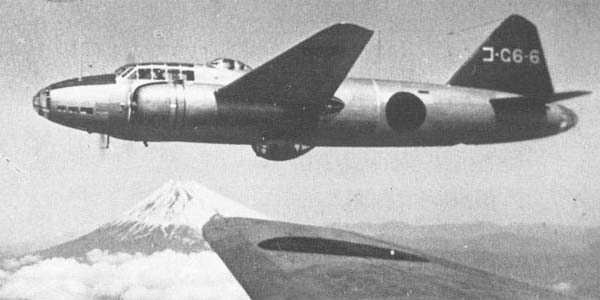
The G6M1 was too heavy and discontinued. The first production bomber was designated the G4M1 (Model 11). Armament consisted of a total of four 7.7 mm Type 92 machine guns placed in the nose, dorsal turret and waist gun positions. One 20 mm Type 99 cannon was installed in the tail. Glazed fuselage gun blisters enclosed the waist gunners. The first bombing missions deep into China were very successful, due to only a token resistance by the Chinese Air Force, but as the war progressed and Allied opposition increased, the deficiencies of the G4M became apparent and an attempt was made to correct this in the G4M1 (Model 12). The G4M1 (Model 12) was powered by two, 1,530 hp (1,140 kW) Kasei 15 engines. The improved engines had a higher power rating at altitude, to enable it to fly above the ceiling of light anti-aircraft fire. Flat glazed panels replaced the fuselage blisters and the tail cone shape was changed. The underside of the fuel tanks was protected by rubber sheeting and a fuel tank Co2 fire extinguisher system was installed. The increased weight of the modifications decreased performance and the range was reduced form 3,749 miles (6,033 km) to 3,553 miles (5,718 km). The ability to sustain battle damage was increased slightly, but casualties during the Solomons campaign were heavy.
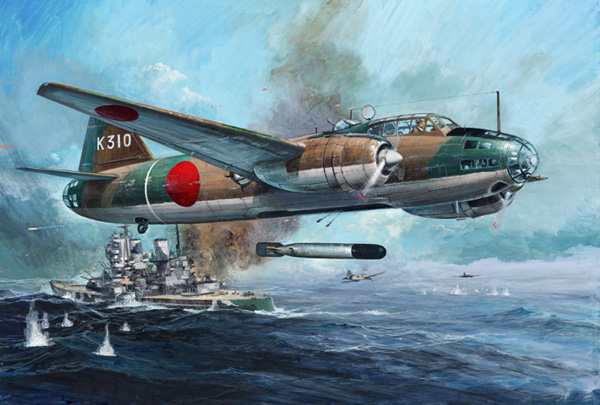
The bomb-bay doors were removed on the G4M1 when carrying a torpedo. The G4M2 (Model 22) was introduced in late 1942 with enhanced performance. It incorporated a laminar-flow wing, enlarged tailplane and increased nose glazing. It was powered by two 1,800 hp (1,340 kW) Kasei 21 engines with water-methanol injection. The wing and tail tips were rounded and a new bomber’s aim window was installed to improve night-bombing accuracy. A 420 gallon (1,590 liter) auxiliary tank was installed, increasing total fuel capacity to 1,715 gallons (6,490 liters). Armament was also increased by adding flexible 7.7 mm machine guns on either side of the nose and the dorsal machine gun was replaced with a 20 mm cannon. The G4M2a Model 22a) introduced bulged bomb-bay doors and was powered by two 1,825 hp (1,360 kW) Kasei 25 engines. Armament was changed by replacing the two 7.7 mm waist machine guns with 20 mm cannons. A substantial number of G4M2a (Model 24B and C) were modified to carry the famous Yokosuka MXY7 Navy Suicide Attacker— Ohka. The bomb-bay doors were removed and special shackles were installed to carry the Ohka piloted missile. This model was redesignated as the G4M2e (Model 24J). The combination bomber and missile was very unwieldy, heavy and slow while approaching targets at 175 mph (280 km/h). It was an easy target for Allied fighters and on March 21, 1945, sixteen aircraft were intercepted and released their Okha missiles short of their targets. The first success of the Ohka was on April 1st, when they hit the battleship West Virginia and three transport vessels. The first Allied ship sunk by an Ohka was the destroyer Mannert L. Abele on April 21st.2
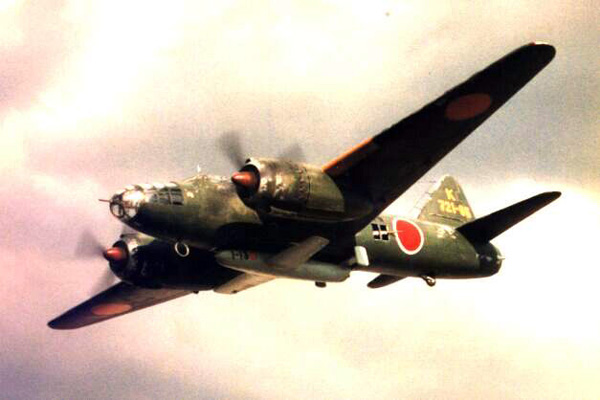
A model of a G4M2e carrying a Yokosuka MXY7 piloted missile. The final version was the G4M3 (Model 34) and it was built as a more combat capable aircraft. It introduced a revised wing structure, self-sealing tanks, and armor protection for the crew. It retained the bulged bay-doors and was powered by two 1,825 hp (1,360 kW) Kasei 25 engines. Fuel capacity was reduced from 1,715 gallons (6,490 liters) to 1,185 gallons (4,490 liters). The tail turret was redesigned based on an American version which resulted in shortening the fuselage. This moved the aircraft C.G. forward and dihedral was added to the horizontal stabilizer to restore aircraft stability. Only sixty G4M3s were produced. The internal bomb load for the G4M1 was of 1,764 lbs (800 kg) or equivalent weight as anti-ship torpedo. The bomb load was increased to 2,205 lbs (1,000 kg) on the G4M2 and G4M3. The G6M1 escort fighter carried no bombs. A total of 2,446 G4Ms and G6Ms were produced between 1941 and 1945. The GM4 was flown in action from Australia to the Aleutians. Its most notable missions were the sinking of the HMS Prince Of Wales and HMS Repulse off the coast of British Malaya on December 10, 1941 and a GM41 was attacked by Lockheed P-38 Lightnings carrying Yamamoto in which he was killed.3
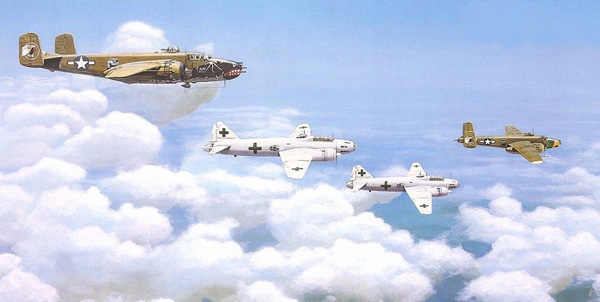
The final mission for the G4M was a solemn one. Dubbed Bataan 1 and Bataan 2, two Bettys painted white with large green crosses on the wings, fuselage and tail carried eight passengers from Japan to Ie Shima that comprised of the Japanese surrender delegation. The delegation included General Torashiro Kawabe, representing Army Chief of Staff Yoshijiro Umezu who refused to participate. The two planes were a G6M1-L2 military transport, Bataan 1, and a second disarmed G4M1 bomber, Bataan 2. The paint scheme was the idea of General McArthur as well as the names which were a reminder of Japanese actions during the Bataan Death March. Escorted by P-38 Lightnings, the planes landed at Ie Shima and the delegates were loaded upon a US Army Air Forces transport plane to complete their flight to Manila. Both planes were allegedly destroyed either by accident or planned scrapping shortly thereafter. Thus was ended the final chapter of the Mitsubishi G4M Betty bomber. |
| Specifications: | |||
|---|---|---|---|
| G4M1 Model 11 | G4M2 Model 22 | G4M2 Model 34 | |
| Dimensions: | |||
| Wing span: | 82 ft 0 in (25 m) | 82 ft 0 in (25 m) | 82 ft 0 in (25 m) |
| Length: | 65 ft 7 in (20 m) | 65 ft 7 in (20 m) | 63 ft 11 in (19.5 m) |
| Height: | 19 ft 8 in (6 m) | 19 ft 8 in (6 m) | 19 ft 8 in (6 m) |
| Weights: | |||
| Empty: | 14,991 lb. (6,800 kg) | 17,990 lb. (8,160 kg) | 18,409 lb. (8,350 kg) |
| Loaded: | 20,994 lb (9,500 kg) | 27,558 lb (12,500 kg) | 27,558 lb (12,500 kg) |
| Performance: | |||
| Maximum Speed: |
266 mph (428 km/h) @ 13,780 ft (4,200 m) |
272 mph (438 km/h) @ 15,090 ft (4,600 m) |
292 mph (470 km/h) @ 16,895 ft (5,150 m) |
| Cruise Speed: |
196 mph (315 km/h) @ 9,485 ft (3,000 m) |
196 mph (315 km/h) @ 13,125 ft (4,000 m) |
196 mph (315 km/h) @ 13,125 ft (4,000 m) |
| Service Ceiling: | 29,365 ft. (8,950 m) | 30,250 ft. (9,220 m) | |
| Maximum Range: | 3,749 miles (6,033 km) | 3,765 miles (6,060 km) | 2,694 miles (4,335 km) |
| Powerplant: | Two 1,530 hp Kasei 11, 14 cyl. radial | Two 1,800 hp Kasei 21, 14 cyl. radial | Two 1,825 hp Kasei 25b 14 cyl. radial |
| Armament: | Three 7.7 mm MG, One 20 mm Cannon | Two 7.7 mm MG, Two 20 mm Cannon | Four 20 mm Cannon |
| Bomb Load: | 1,764 lbs. (800 kg) | 2,205 lbs. (1,000 kg) | 2,205 lbs. (1,000 kg) |
| Endnotes: | |
|---|---|
|
1. Rene J. Francillon, Japanese Aircraft of the Pacific War. Annapolis, Maryland: Naval Institute Press, 1995. 378. 2. David Mondey. The Concise Guide to Axis Aircraft of World War II. New York: Smithmark Publishers, 1996. 203. 3. Carroll V. Glines. Attack On Yamamoto. New York: Orion Books, 1990. 57-76. 4. William Green. Famous Bombers of the Second World War. Garden City, New York: Doubleday & Company, Inc., 1975. 118-124. | |
©Larry Dwyer. The Aviation History Online Museum.
All rights reserved.
Created November 21, 2006. September 6, 2014.